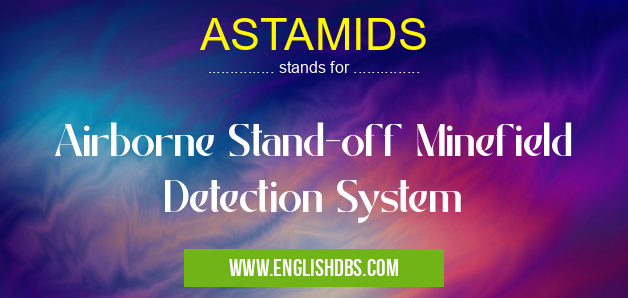What does ASTAMIDS mean in MILITARY
The Airborne Stand-off Minefield Detection System (ASTAMIDS) is an advanced system designed to detect and identify buried or buried surface-laid mines in both land and sea environments. The ASTAMIDS utilizes a combination of laser, infrared, electro-optic, radar, acoustic and magnetometer sensor technologies to enable effective detection of underwater, landmines and unexploded ordnance from a safe standoff distance. ASTAMIDS is capable of providing real-time intelligence on the location and characteristics of potential threats that may be present in hazardous locations.

ASTAMIDS meaning in Military in Governmental
ASTAMIDS mostly used in an acronym Military in Category Governmental that means Airborne Stand-off Minefield Detection System
Shorthand: ASTAMIDS,
Full Form: Airborne Stand-off Minefield Detection System
For more information of "Airborne Stand-off Minefield Detection System", see the section below.
» Governmental » Military
Overview
ASTAMIDS is a state-of-the-art system developed to detect landmines, underwater obstacles and other objects of concern in complex environments. It incorporates a variety of different sensor technologies including but not limited to laser, infrared, electro-optic, radar imaging sensors as well as acoustic and magnetic detectors. ASTAMIDS provides real time situational awareness data enabling quick response and accurate visualisation for enhanced safety operations by detecting hidden threats before they can cause harm. Additionally, the ASTAMIDS platform can be deployed both on aircrafts or vessels allowing it to effectively detect threats over vast distances without endangering personnel on the ground or at sea.
Essential Questions and Answers on Airborne Stand-off Minefield Detection System in "GOVERNMENTAL»MILITARY"
What is Airborne Stand-off Minefield Detection System?
Airborne Stand-off Minefield Detection System (ASTAMIDS) is a system designed to detect landmines from the air. It uses high-power lasers and advanced imaging algorithms to identify potential minefields, allowing military personnel to carefully map out areas and prevent the accidental detonation of buried explosives.
How does ASTAMIDS work?
ASTAMIDS works by using a combination of powerful laser scanning, advanced imaging algorithms, and computer vision algorithms. The laser scans the terrain and looks for suspicious objects that might indicate a minefield. Once identified, the system then produces an image which can be analyzed to determine what objects lie beneath the surface.
What are the benefits of ASTAMIDS?
ASTAMIDS offers several key benefits over traditional detection methods. By being able to accurately scan large areas from a safe distance, it eliminates the need for human operators to physically enter dangerous areas in order to mark potential danger spots. Additionally, its advanced imaging algorithms can allow for better accuracy when identifying potential minefields, thus reducing the likelihood of false positives or missed threats.
How accurate is ASTAMIDS?
The accuracy of ASTAMIDS depends on numerous factors such as weather conditions, terrain type, and how well the system has been calibrated before use. However, on average it can achieve up to 99% accuracy when detections are made in clear weather conditions on open terrain types such as deserts or plains. This can be further improved by enabling additional features such as thermal imaging or multi-spectral sensors which help further increase accuracy levels even under adverse conditions.
Who uses ASTAMIDS?
ASTAMIDs is primarily used by militaries around the world for detecting potential mine fields in conflict zones or other dangerous areas where manually surveying land may not be feasible or safe due to conflict or risk posed by hazardous materials like unexploded ordinance; it is also increasingly being used more broadly in humanitarian operations and disaster response settings where its capability in rapidly surveying land can help protect those affected from explosive hazards like landmines left over from previous conflicts or natural disasters like floods or earthquakes uncovering hidden explosives close to populated areas.
What equipment do I need for using ASTAMIDS?
In order for a user to employ an airborne stand-off minefield detection system on their own aircraft platform there needs be several key components installed; these include a MultiSpectral Imaging Sensor (MSI), Laser Scanner Lidar)(LSL), Computer Visualization software, Global Positioning System (GPS) hardware linked with special mission software and a data recorder capable of storing all data collected during mapping missions so it can be examined post flight back at base stations if any impacts are detected.
Final Words:
In summary, the Airborne Stand-off Minefield Detection System (ASTAMIDS) is an advanced system designed to detect underground objects such as landmines or unexploded ordnance from a safe distance away using a range of different sensor technologies. This system enables enhanced safety operations with real time data while also reducing the risk to personnel directly involved with the mission. ASTAMIDS has been successfully used in numerous missions around the globe showing its great effectiveness at detecting hidden threats before they can cause harm.
